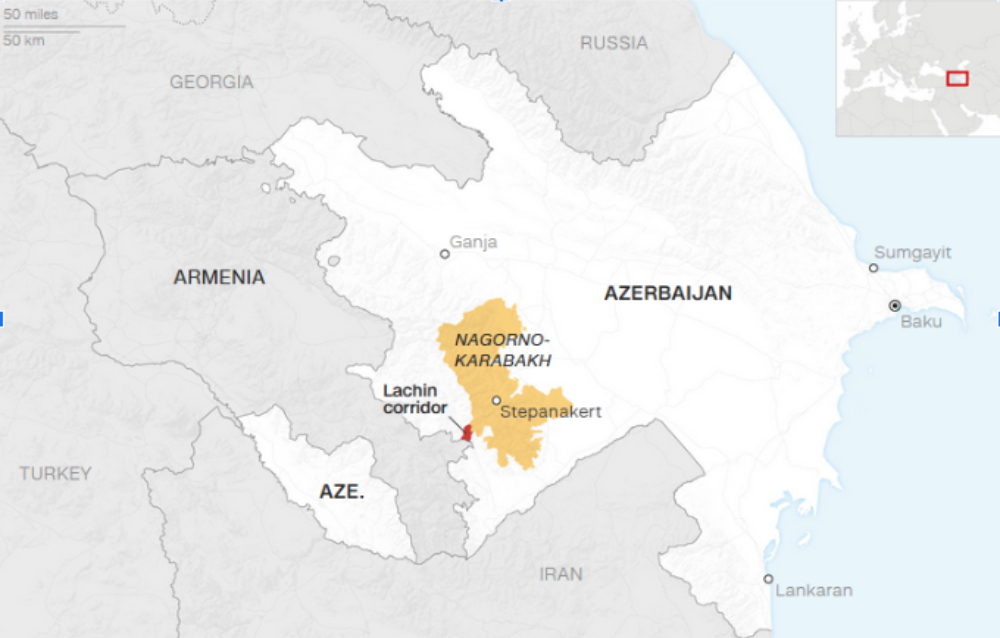
By Competent Boards alumnus Ani Hotoyan-Joly, Independent Board Member with experience in public, crown and non-profit organizations.
Armenians around the world are mourning the loss of The Republic of Nagorno-Karabakh. This republic is known as Artsakh to Armenians around the world.
You might be wondering where Nagorno-Karabakh is and why we are mourning its loss.
Artsakh is located in Azerbaijan but has for decades been run autonomously with a self-proclaimed de facto government from its capital, Stepanakert. See the map below, courtesy of CNN.
This beautiful mountainous region, which I visited in 2015, was until a few days ago, populated entirely by about 120,000 Christian ethnic Armenians.
A quick lesson in history:
Artskah has been the ancestral home of ethnic Armenians for thousands of years. In 1923, Joseph Stalin decided that for administrative purposes, despite almost 100% of its population being Armenian, it should fall under the section of USSR ruled by Azerbaijan instead of Armenia.
In 1988, Artsakh officials passed a resolution declaring their intention to join the republic of Armenia. Nagorno-Karabakh and Soviet Armenia called on the Soviet authorities to transfer the region from Azerbaijan to Armenia, citing self-determination laws in the Soviet constitution. This request was rejected and this led to the first Karabakh War, which lasted from February 1988 to May 1994. Over the 6 years, about 30,000 people lost their lives and when the war ended in 1994, Armenia took control of the region from Azerbaijan. Other than a few clashes here and there, peace lasted until September 27, 2020 when the world was pre-occupied with Covid19, Azerbaijan, backed by its ally Turkey, attacked Artsakh. This time, this war was fought by Artsakh’s and Armenia’s military leading to massive losses on both sides. Unfortunately, Artsakh’s and Armenia’s military were overpowered by the Azerbaijan’s military as the latter used drones supplied by Turkey and Syrian mercenaries during the war. After 44 days of intense fighting, a ceasefire was brokered by Russia and Russian troops were placed in the region to keep the peace.
Without provocation, on December 12, 2022, Azerbaijan closed the Lachin Corrido, a 5 km wide road leading from Artsakh to Armenia. The main reason for this move was to starve the people living in Artsakh and to “bring them to their knees”. They cut the supply of gas, electricity and the transportation of food and basic supplies such as flour, cooking oil, diapers and personal care items from entering Artsakh from Armenia. In addition, people were not allowed to enter or leave the region. Families were separated for months. The goal was to starve these people and to force them to integrate into Azerbaijan and accept Azerbaijani citizenship. Armenians don’t trust Azerbaijan and could not accept this “integration” offer. They knew they could not live safely under the Azerbaijani rule.
According to Article II of the UN Convention on the Prevention and Punishment of the Crime of Genocide, genocide is committed when acts are committed with intent to destroy, in whole or in part, a national, ethnical, racial or religious group. Article II(c) notes that “deliberately inflicting on the group conditions of life calculated to bring about its physical destruction in whole or in part” is genocide. Therefore, prevention of the provision of supplies to starve people and bring physical destruction on people is Genocide. What has happened in Artsakh is then genocide. This is similar to what the Ottoman Empire (Turkey) did to Armenians in 1915, forcibly displacing the Armenian population from their homelands (currently located in eastern Turkey) and killing them directly and by starving them. My mother’s and father’s grandparents and relatives all died during the first Genocide of the 20th century. I never imagined that history would repeat itself and I would bear witness to the second Genocide of the Armenians.
What has happened since September 19, 2023?
On September 19th, Azerbaijan started shelling towns, civilians and military bases in Artsakh by using illegal cluster bombs. In 24 hours, Artsakh was overpowered and to avoid more bloodshed, on September 20th, the government of Artsakh agreed to a ceasefire and agreed for Artsakh to cease to exist effective January 1, 2024. On September 24th, the Lachin Corridor was reopened and Armenians from Artsakh started fleeing for safety leaving behind their homes, their lands, their animals and most importantly, the graves of their lost sons, daughters, brothers, sisters, mothers and fathers who heroically fought and died during the first and second Artsakh wars.
I saw this Facebook posting by an Armenian who left her home in September 2023 and is now a refugee in Armenia:
“I thought about setting my house on fire, but I didn’t. I washed the dishes, arranged them on the shelves, as if I was waiting for visitors. This year, the crop of dates is very good. Let the Azeris eat them. I left them (Azeris) a letter; in it I wrote: ‘In this house lived hard-working and honourable people, keep it clean. And please water my flowers.'”.
What happens now and what about the future?
As of October 1st, 100,514 Armenians including thousands of children have arrived in Armenia becoming refugees overnight. They need food, shelter, medical assistance and financial support.
The international community has the responsibility to support these refugees and punish Azerbaijan with sanctions. Imposing sanctions on Azerbaijan would send a strong message that ethnic cleaning cannot be tolerated.
Armenians in diaspora and concerned citizens can help by raising awareness about the situation in Artsakh and the plight of these Armenians, now refugees in Armenia. You can help by supporting the not-for-profit organizations that are helping the people on the ground such as:
UNHCR
International Orthodox Christian Charities
Armenian Relief Society of Canada by visiting their website and making a donation through Canada Helps to “Artsakh Fund”. I have been a member of this charitable organization for many years and I am currently the chair of the Toronto “Roubina” chapter.
Back To News & Views